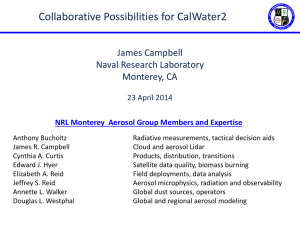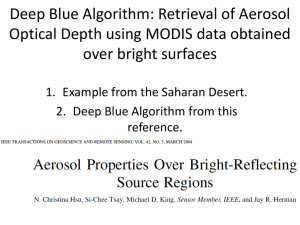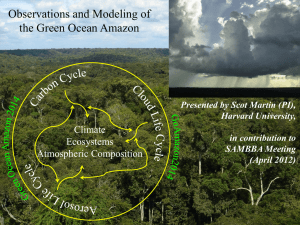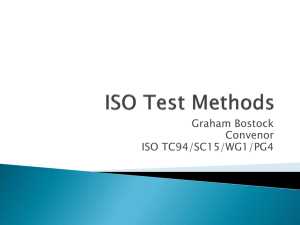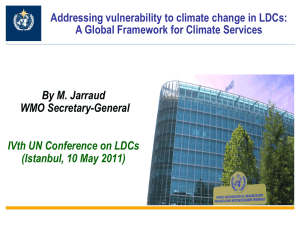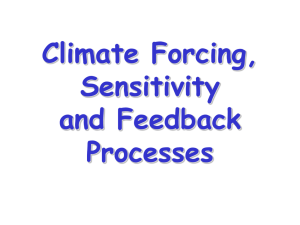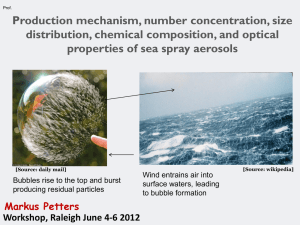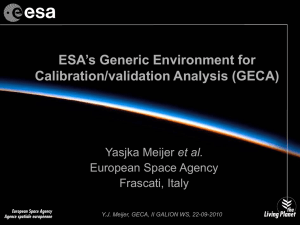Optical particle properties and aerosol typing
advertisement
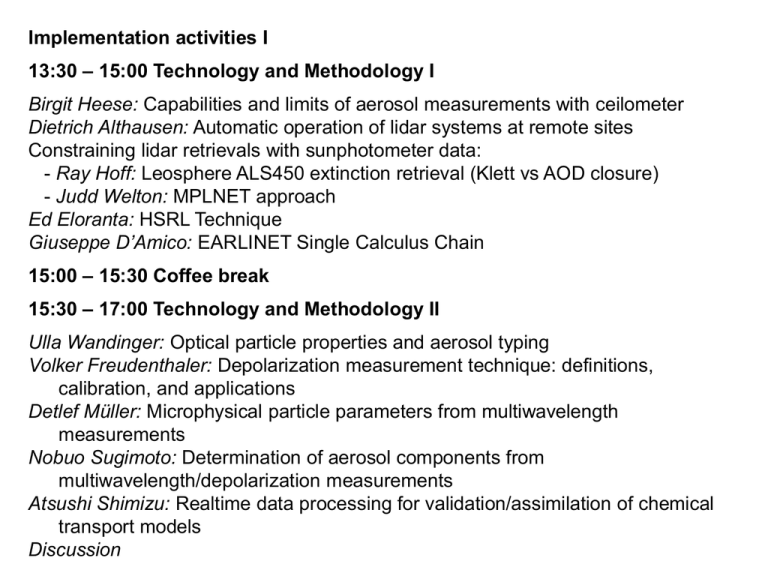
Implementation activities I 13:30 – 15:00 Technology and Methodology I Birgit Heese: Capabilities and limits of aerosol measurements with ceilometer Dietrich Althausen: Automatic operation of lidar systems at remote sites Constraining lidar retrievals with sunphotometer data: - Ray Hoff: Leosphere ALS450 extinction retrieval (Klett vs AOD closure) - Judd Welton: MPLNET approach Ed Eloranta: HSRL Technique Giuseppe D’Amico: EARLINET Single Calculus Chain 15:00 – 15:30 Coffee break 15:30 – 17:00 Technology and Methodology II Ulla Wandinger: Optical particle properties and aerosol typing Volker Freudenthaler: Depolarization measurement technique: definitions, calibration, and applications Detlef Müller: Microphysical particle parameters from multiwavelength measurements Nobuo Sugimoto: Determination of aerosol components from multiwavelength/depolarization measurements Atsushi Shimizu: Realtime data processing for validation/assimilation of chemical transport models Discussion Optical particle properties and aerosol typing Ulla Wandinger Leibniz Institute for Tropospheric Research, Leipzig, Germany Second GALION Workshop, WMO, Geneva, 20-23 September 2010 Motivation • GALION as global network • spaceborne lidars as global observation systems → long-term, global observations → global aerosol distribution and climatology → long-term trends → distinguish natural and anthropogenic aerosols → separate “unhealthy” aerosols → need to define common aerosol types, distinguish aerosol components Second GALION Workshop, WMO, Geneva, 20-23 September 2010 Aerosol types vs aerosol components OPAC (Database on Optical Properties of Aerosols and Clouds, Hess et al. 1998) Aerosol types Aerosol components Insoluble Water-soluble Soot Sea-salt: accumulation mode coarse mode Mineral: nucleation mode accumulation mode coarse mode transported Sulfate droplets Continental: clean average polluted Urban Desert Maritime: clean polluted tropical Arctic Antarctic Mineral transported Free troposphere Stratosphere Second GALION Workshop, WMO, Geneva, 20-23 September 2010 Tools multi-wavelength, extinction, backscatter and depolarization lidar instruments → retrieval of microphysical properties - depends mainly on spectral information „3+2“ (backscatter at 355, 532, 1064 nm, extinction at 355, 532 nm) - depolarization information important for particle shape (Kernel functions for Mie scatterers or non-spherical scatters) → aerosol and cloud type classification relies on intensive particle parameters - lidar ratios (355, 532 nm) - color ratios/Ångström exponents (extinction and backscatter) - particle depolarization ratio → knowledge on wavelength conversion factors is required for single-wavelength lidars or space-borne measurements (see ESA study) Second GALION Workshop, WMO, Geneva, 20-23 September 2010 aerosol type classification Pure Saharan Dust Aged Saharan Dust Biomass Burning Aerosol + Mineral Dust Canadian Biomass Burning Aerosol Industrial Pollution Aerosol Marine Aerosol - different aerosol types cluster and can be distinguished - spread of the clusters is limited by natural variations in the end Petzold et al. ESA -ICAROHS, 2009 Esselborn et al., Appl. Opt., in preparation BUT: Inversion of microphysical properties and determination of aerosol types from intensive optical properties require high accuracy and precision of the primary optical data! How do we get such data? Second GALION Workshop, WMO, Geneva, 20-23 September 2010 Approach for a trustworthy aerosol typing 1) quicklook → 2) extensive optical data Backsc. Extinc. 0.9±0.2 0.9±0.2 1.1±0.3 47±5 50±6 → 3) intensive optical data Lidar rat. Angstr. Depol. Dust layer → layer-mean values: 54±6 46±3 including error bars for all quantities! Second GALION Workshop, WMO, Geneva, 20-23 September 2010 0.09±0.01 0.06±0.01 0.40±0.07 0.30±0.10 1) Quicklooks are important - Range-corrected backscatter at the longest wavelength - Depolarization ratio (if available, volume depol is sufficient for quicklook) What situation do I deal with? Are there clouds? At which height/temperature? Do they depolarize? Are they penetrated? Are there distinct aerosol layers? At which height? Do they depolarize? What is their origin? (dust forecast, fires, smog,…???) → select appropriate time intervals (with/without clouds, homogeneous conditions) → choose appropriate averaging lengths - do not mix clouds and aerosols, check carefully for settling crystals and droplets (rain, drizzle) - do not mix different aerosol layers → look for useful calibration ranges Second GALION Workshop, WMO, Geneva, 20-23 September 2010 2-3 Aug 2001 22:00 0:00 2:00 4:00 Second GALION Workshop, WMO, Geneva, 20-23 September 2010 SAMUM, Morocco, 2006, dust storm Second GALION Workshop, WMO, Geneva, 20-23 September 2010 2) Evaluate specific „scenes“ (pre-selected time periods) Calculate the primary data: Extinction coefficients (355, 532 nm) Backscatter coefficients (355, 532, 1064 nm) Particle(!) depolarization ratio Calculate errors, choose appropriate averaging lengths Error propagation formulas are valid for errors <20%!!! Have in mind that further calculations may be performed with the data (i.e. further error propagation!) Providing errors is essential! Second GALION Workshop, WMO, Geneva, 20-23 September 2010 3) Calculate intensive parameters, cross-check the data Color ratios b(1064 nm)/b(532 nm) b(532 nm)/b(355 nm) a(532 nm)/a(355 nm) Lidar ratios (355, 532 nm) Ångström exponents a-related b-related Useful regions only! (error!) Check whether these data make sense in the present situation! 4) Re-evaluate the data, if you find „strange“ results!!! Second GALION Workshop, WMO, Geneva, 20-23 September 2010 Always critically check the calibration of the backscatter! baer (zref) << bmol (zref) is often not valid for long wavelengths! → scenes with cirrus clouds (neutral backscatter) are very helpful to train or to investigate specific problems Second GALION Workshop, WMO, Geneva, 20-23 September 2010 What are reasonable values for aerosols? Lidar ratio (355, 532 nm) Particle depolarization ratio (355, 532 nm) 25 (marine)….50 (urban)…80 sr (fresh smoke) <5% („normal“)…10% (mixed dust)…35% (dust,ash) Color ratios b(1064 nm)/b(532 nm) b(532 nm)/b(355 nm) a(532 nm)/a(355 nm) 0.35 (fresh, small)….0.4–0.5….0.95 (large, sea salt) 0.45 (fresh, small)….0.5–0.7….0.95 (large, sea salt) 0.4 (fresh, small)….0.5…. 1 (smoke, sea-salt) Ångström exponents backscatter-related å(532/1064) backscatter-related å(355/532) extinction-related å(355/532) 1.5 (fresh, small)….1.4–1.0….0.1 (large, sea salt) 2.0 (fresh, small)….1.4–1.0….0.1 (large, sea salt) 2.0 (fresh, small)….1.4–1.0….0.0 (smoke, sea-salt) Ratio of lidar ratio S(355 nm)/S(532nm) 0.8…1.2 ??? Ratio of depolarization ratio d(355 nm)/d(532 nm) 0.8…1.2 ??? Intensive parameters should remain stable within distinct layers and within time! Second GALION Workshop, WMO, Geneva, 20-23 September 2010 „Alarm bells“ - Color ratio b(1064 nm)/b(532 nm) < 0.4, Ångström exponent > 2 → check your calibration at 1064 nm! reference value too small? - Lidar ratio < 30 sr (under non-marine conditions) → check for cloud remnants! → check your overlap correction! extinction too low? - Lidar ratio > 80 sr → check your statistical error! sufficient averaging? → check your b-calibration! reference value too small? Second GALION Workshop, WMO, Geneva, 20-23 September 2010 Second GALION Workshop, WMO, Geneva, 20-23 September 2010 Optical properties, Potenza, 17 May 2008, 20:22 – 20:52 UT 0.90±0.06 0.76±0.07 0.58±0.05 0.96±0.03 0.85±0.03 0.71±0.03 66±7 44±6 75±4 51±5 Second GALION Workshop, WMO, Geneva, 20-23 September 2010 74±8 58±4 1.0 ±0.5 0.4 ±0.1 0.38±0.08 79±5 60±7 1.0 ±0.2 0.30±0.06 0.28±0.02 What information can we use for aerosol typing? Intensive aerosol parameters: - particle depolarization ratio (at 355, 532...1064 nm) - particle lidar ratio (at 355, 532 nm) - Ångström exponent or color ratio (backscatter and/or extinction) Extensive aerosol parameters: - extinction and backscatter coefficients (thresholds) Auxiliary information: - height range (e.g., PBL, stratosphere) - temperature - geographical location/surface (arctic, ocean, desert) - source information + transport modeling Second GALION Workshop, WMO, Geneva, 20-23 September 2010 per layer Distribution of major aerosol components from Tegen et al., JGR, 1997 Second GALION Workshop, WMO, Geneva, 20-23 September 2010
